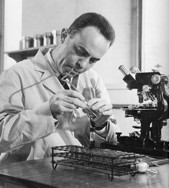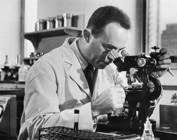The Dynamics of Phagocytosis and Lysosomal Fusion: How White Blood Cells Kill Infectious Invaders

Hirsch, James
Courtesy of Prism Production, Inc.
In the first half of the twentieth century most scientists who studied infections and the body's response to them focused on bacteria and the chemistry of immune defenses. At a time when little was known about the specialized cells of the immune system, James G. Hirsch (1922-1987) pioneered the study of phagocytosis—the process by which white blood cells, or leukocytes, engulf and destroy infectious microbes. This research helped launch the new field of cellular immunology.

Hirsch, James
Making a white cell count.
Courtesy of Prism Production, Inc.
Hirsch discovered in 1956 that leukocytes contain a substance that kills bacteria, which he called phagocytin. Then he investigated the details of how leukocytes surround and destroy invading organisms. Using techniques of cinematography and electron microscopy he was able to visualize the workings of the lysosome, a sac within the leukocyte that contains digestive enzymes. The images demonstrated for the first time how—after a microbe is engulfed—the white cell's outer membrane fuses with the lysosome, exposing the bacteria to toxic enzymes and other chemicals. In so doing, the images made clear the important link between phagocytosis, lysosomal fusion, and immune defenses.
James G. Hirsh graduated from Yale University in 1942 and received the MD from Columbia University's College of Physicians and Surgeons in 1946. After an internship at Barnes Hospital in St. Louis, he served in the military from 1948 to 1950 as chief of medicine at the hospital at Warren Air Force Base in Cheyenne, Wyoming. He joined the Rockefeller Institute as a visiting investigator in 1950 and remained there the rest of his research career, becoming professor in 1960. After retirement from Rockefeller, Hirsch served as president of the Josiah Macy, Jr. Foundation from 1981 to 1987. Hirsch was elected to the U.S. National Academy of Sciences and to the Institute of Medicine. He was an editor of the Journal of Experimental Medicine from 1973 to 1981, and served on the editorial boards of several other journals.

A polymorphonuclear leucocyte at rest. From J Exp Med, 1964, 120: 569-576 (plate 53)
Selected Publications
Hirsch JG. Phagocytin: A bactericidal substance from polymorphonuclear leucocytes. J Exp Med, 1956, 103: 589-611
http://www.jem.org/cgi/reprint/103/5/589
Hirsch JG. Studies of the bactericidal action of phagocytin. J Exp Med, 1956, 103: 613-621
http://www.jem.org/cgi/reprint/103/5/613
Cohn ZA and Hirsch JG. The isolation and properties of the specific
cytoplasmic granules of rabbit polymorphonuclear leucocytes. J Exp Med,
1960, 112: 983-1004
http://www.jem.org/cgi/reprint/112/6/983
Hirsch JG and Cohn ZA. Degranulation of polymorphonuclear leucocytes
following phagocytosis of microorganisms. J Exp Med, 1960, 112:
1005-1014
http://www.jem.org/cgi/reprint/112/6/1005
